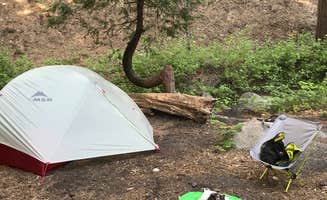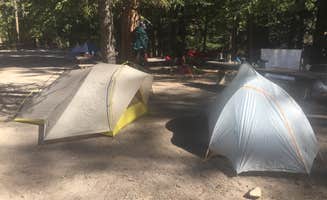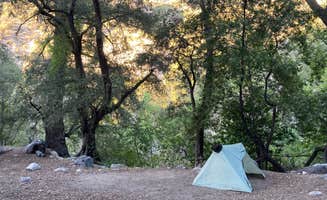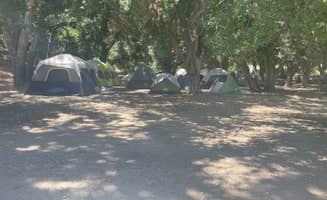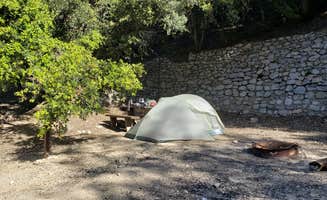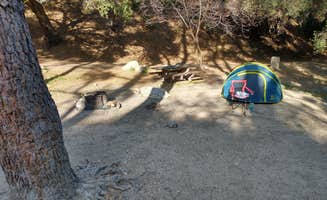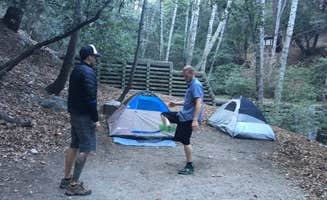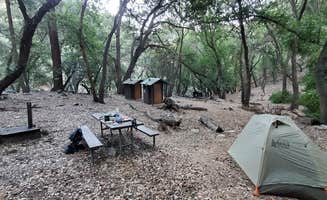Tent campgrounds within Angeles National Forest require 2-7 mile hikes to reach, with elevations ranging from 2,000-5,700 feet. The area receives approximately 15-25 inches of precipitation annually, concentrated in winter months, creating seasonal water availability in streams and at springs. Summer temperatures frequently exceed 90°F at lower elevations while winter conditions can include snow above 4,000 feet.
What to do
Waterfall hiking: Multiple trail camps serve as bases for waterfall exploration. At Millard Trail Campground, a half-mile trail leads to Millard Falls with easy terrain suitable for families. "Fun little campground with decent facilities and beautiful surroundings. Lots of trails all around with a nice hike of about 1/2 mile up to Millard Falls that is easy for kids and grown ups," reports one visitor.
Stargazing: Higher elevation camps provide optimal night sky viewing away from city light pollution. At Cooper Canyon Trail Campground, "At night, you have an amazing view of the sky. You can relax at camp or get back on the PCT and check out some falls," one backpacker notes. The campsite's 5,700-foot elevation significantly reduces light interference.
Mountain biking: Several trail networks accommodate cyclists, with camps serving as overnight stops. "Bikepacked in for a quick overnighter. Settled on one of the 6 tent sites. Nice campground, active stream in the middle of summer. Waterfall 30 minutes hike upstream," reports a cyclist about Millard Trail Camp.
What campers like
Secluded stream-side sites: Many forest campgrounds feature nearby water access, important for both cooling off and filtering drinking water. At Bear Canyon Campground, a hiker notes, "Follow the creek (which is GORGEOUS with waterfalls and shade in the spring) and go all the way to the end. Trail tends to get iffy at points, but you kinda get to know the flow of it if it disappears into rocks or the creek."
Seasonal wildflowers: Spring months bring abundant wildflower displays at mid-elevation campsites. "It's a nice little getaway without leaving the city, perfect for a one nighter or to backpack in with the kiddos. It's around 2 miles to camp on a leveled surface with a few stream crossings," a camper shares about Gould Mesa Trail Campground.
Wildlife viewing: Dawn and dusk bring opportunities for wildlife observation at less-trafficked sites. "I have woke in the morning to deer on several occasions," reports a repeat visitor to West Fork Trail Campground. Most wildlife encounters involve deer, rabbits, and various bird species.
What you should know
Trail conditions: Access routes frequently present challenges beyond distance. "Trail leading to the camp can also be filled with downed trees. Takes a little climbing and going around obstacles but not too bad," warns a hiker about Valley Forge Trail Camp.
Water availability: Stream flow varies dramatically by season. "It is a challenging hike if you have a heavy pack. However, there is a utility road you can take that would make it 100% easier. No water facet but there is a toilet," advises a West Fork Trail camper who visits during spring months.
Car security: Trailhead parking areas occasionally experience break-ins. "WARNING: Make sure to leave your car doors unlocked, and nothing of value inside. You'd rather have someone root through your car and walk away empty handed than have a window broken and items stolen," cautions a Millard Trail Camp visitor.
Campsite privacy: Proximity to popular day-hiking routes affects some locations. "This campground is not a campground if you want to get away from people because there is a lot of people passing by looking at you. You can't really be isolated or have privacy even though it is a campground," notes a Millard Trail Camp reviewer.
Tips for camping with families
Best tent camping near Angeles National Forest for first-time backpackers: Mount Lowe Trail Campground offers beginner-friendly hike-in experiences. "This is a hike in only campground that is secluded and a little spare. It has no running water but it does have facilities and tables (first come, first serve). Fantastic views on a clear day," notes a visitor. The 2.5-mile access trail maintains moderate grades.
Kid-friendly creek exploration: Several campgrounds feature shallow stream access for supervised play. "Scoped it out a few weeks ago and thought it was an easy enough hike for a beginner (me) and his pal camp at. There were a dozen or so mountain bikers and about the same amount of hikers runners that venture by the campground throughout the day," reports a Gould Mesa camper.
Short hike options: Some trail camps require minimal hiking distances, suitable for younger children. Cooper Canyon Trail Camp visitor notes, "I've backpacked it with friends and even kids, you can take the road or the trail down to camp but I'd suggest the PCT for the scenic views. It's around 2 to 3 miles exposed on the road and somewhat shaded on the trail."
Tips from RVers
Trailhead parking restrictions: Large vehicles face limitations at most forest access points. "The road has a gate on it, which is locked 8pm-6am. That was day 1 (we slept in our car). Once past that gate, you'll soon hit another, this one closed to all motorized vehicles," cautions a Mount Lowe visitor, highlighting the need for appropriate vehicle positioning.
Overflow options: During peak periods when tent sites fill, nearby developed facilities provide alternatives. "Safe, Clean Basic Parking lot at a Fairground," describes one camper about Antelope Valley Fairgrounds, located 30 minutes from forest boundaries. "Clean showers and bathrooms. Full RV hook-ups. It's absolutely nothing to write home about and really has no personality, trees, or privacy."



